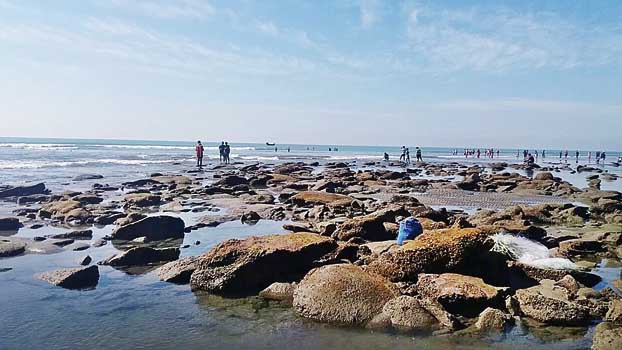St Martin’s conservation gets priority

The government has decided to conserve the biodiversity of St Martin's Island by undertaking initiatives to discourage commercial tourism in the country’s only coral island.
The decision has been made as coral reefs not only provide a sanctuary to a myriad of marine life but also play an important role in protecting the coastline from erosion.
Officials said the Island, the most attractive tourist spot in the country, will be reserved only for nature-lovers.
The dumb-bell-shaped island has been identified as an ecologically endangered area. Entry of tourists has been restricted in Cheradwip southern part and main coral colonies of the island. Some more steps will be taken to conserve its nature and environment. The most important step is to regulate the rampant entry of tourists in the Island.
Mallik Anowar Hossain, Joint Secretary (Tourism) of Civil Aviation and Tourism ministry, told The Bangladesh Post, “The policy decision has been finalized so that not more than 1200 -1500 tourists will be allowed to enter there on a daily basis. Only 300-400 of them will be allowed to night-stay there.”
“An inter-ministerial committee comprising eight ministries is working on St. Martin's. The committee has sent some of its proposals to the Prime Minister's Office for final approval”, he said.
“Process is already underway to build technical and administrative infrastructure to regulate the tourists,” he continued
Explaining the aim of the decision, Mallik Anowar Hossain said, an initiative has been taken to discourage commercial tourism to this Island of unique and rare natural features, but to keep open for nature-lovers for research and studies.
St. Martin’s, the only place in Bangladesh, where alive coral colonies are found, is a natural treasure that attracts thousands of tourists. The Island also has an important ecological value as one of the few remaining nesting places in the region for several species of globally threatened marine turtles, as well as being a flyway and winter site for migratory birds of the East Asian and Australasian region. St. Martin’s Island is not only significant for its biodiversity value, but also important for Bangladesh in defining its Exclusive Economic Zone EEZ and delineating its sea boundary in accordance with the United Nations Convention on the Law of the Sea.
More than half a million tourists visit the island, which covers an area of eight and a half square kilometers with 10,000 permanent residents. As a popular tourist site on the tiny Island, there are around 150 hotels, guest houses and restaurants.
Unregulated tourism has become detrimental to unique ecosystem of the island. Unless tourists visiting St. Martin’s Island quickly adopt ecologically responsible behaviour, the unique flora and fauna, that have experienced tragic changes over the last two decades, will continue to be degraded.
The island is over a thousand years old. The government declared the island an Environmentally Critical Area (ECA) in 1999. That is, no work can be done here that harms the water, soil, air or animals of the island.
In 2016, the Department of Environment took up a project named ecosystem based development, management and conservation of Saint Martin's Island at a cost of Tk1584.78 thousand. The aims of the project are: enhancing biodiversity of the Saint Martin’s Island, engaging community in conservation initiatives and improving their livelihood, promoting eco-tourism, conducting research, innovating and implementing conservation measures for coral and associated flora and fauna, developing waste management system at Saint Martin’s Island; and enhancing capacity of the Department of Environment and Sharing.
Soliaman Haider, Director of Department of Environment also St. Martin’s Project Director,said in order to protect the environment of this very important area of the country, various activities are being carried out under the project including raising public awareness. Hundreds of people have been trained, and campaigns have been launched to create environmental awareness among tourists.
Multiple initiatives, including restriction for tourists, are being implemented, which will make the St. Martin Island a special protected area, he added.
Already, tourists and all types of human entry are prohibited since last week at Cheradwip, the southernmost tip of the Island and a rocky reef that is about 1.8 km long and between 50 and 300 m wide.
According to a survey conducted by The United Nations Development Program (UNDP) and Department of Environment in 2010 out of the 15 reef-building scleractinian (stony or hard) coral families, 10 are present on the Island, represented by approximately 22 genre and 66 species. Of these, 39 species have been identified alive around the Island. In addition, 14 species of soft coral have been recorded, growing in water up to a depth of 7 meters.
Several international studies said St. Martin’s had 141 species of coral in 1980 but it dropped to 41 in 2016. If protection is not strictly done, the island may become coral-less by 2045.
Locals are protesting against any kind of restriction on tourism. That is why the government is taking steps to ensure that their livelihoods are not affected.
Nur Ahamad, Chairman of St Martin’s union council, said, primary measures must be taken to prevent erosion that is going on the north-western side of the Island. Then a planned waste management system must be developed to save the Island, he added.



